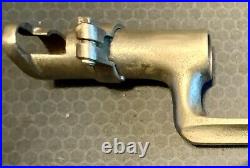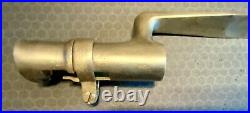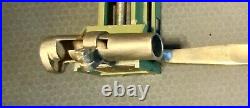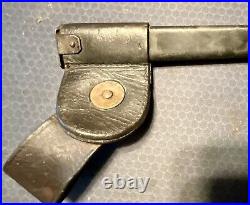
















“American Socket Bayonets and Scabbards”, Figure B140. WINCHESTER MODEL 1873 MUSKET BAYONET. This weapon is one of those few, and probably best known, of those bayonets where the mortising is cut so that it is positioned beneath the barrel instead of to the side in the normal manner. As may be seen in Figure B140, the bridge is positioned on the socket ninety degrees to the obverse side of the axis of the shank. This, in conjunction with the rifle’s bayonet stud/front sight automatically positions the blade beneath the barrel. Finishes on this bayonet will be found either bright or blued, with the latter provided with rifles produced for the export market. The overall length is 21 inches, including a thin, 3 inch socket and an 18 x 3/4 inch blade with its 16 inch face flute. There are no markings. The bridge is quite thin as shon, and along with the locking ring arch, is unusually high so as to accomodate the rifle’s tall front sight. The very short shank is only 3/4 inch long. The bore diameter is 063 inch and the muzzle length, 1-1/4 inches. Aside trom the regular Model 1873 musket, or “infantry rifle, ” for which this bayonet was intended, it was also used on modified Model 1866 3rd Type carbines with shortened magazines. The total-number of bayonets produced specifically for Winchester muskets. Is not known, but based on surviving specimens, was no doubt relatively small. Whether all included bayonets seems doubtful. Bayonet measures 21.25 overall with a blade length of 18.25, the inside diameter of the socket ar (1861-65) is. Condition of bayonet is very good. Only some residual micro pitting keep it from being excellent condition. Scabbard and Frog are in excellent condition. Scabbard is a Mckenney with the Pennsylvania National Guard mark on the raised brass escutcheon. This scabbard was not officially adopted by the war department, however, it has been acknowledged that New York and Pennsylvania contracted for these scabbard/frogs.
